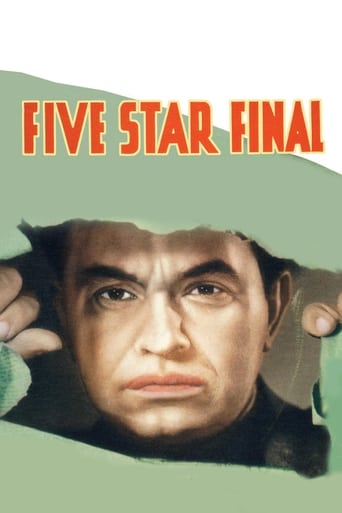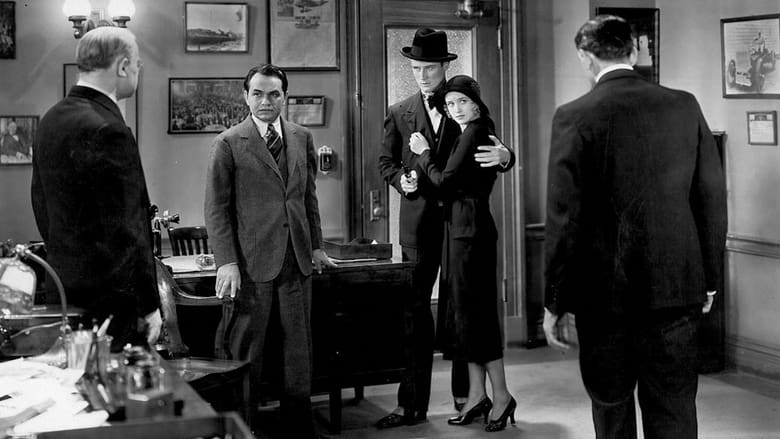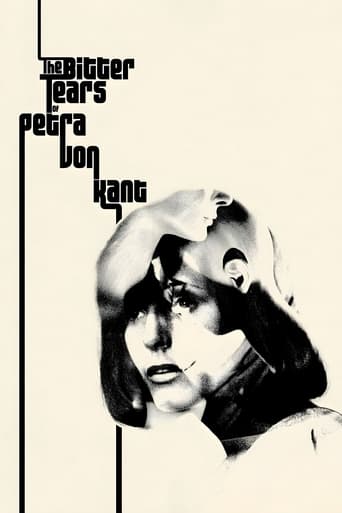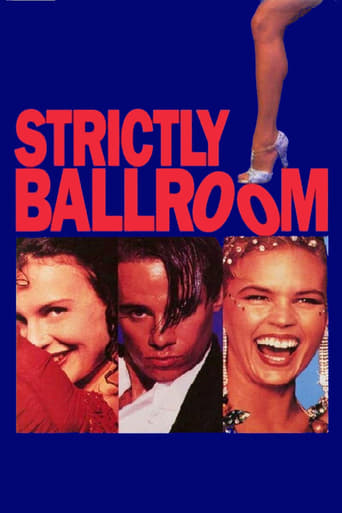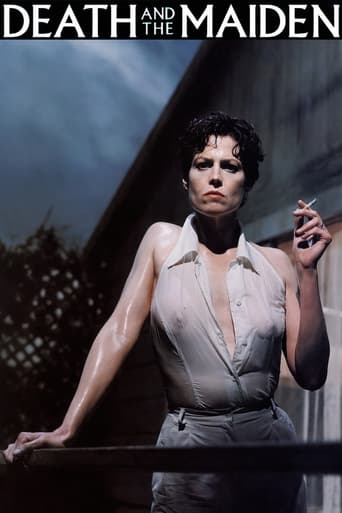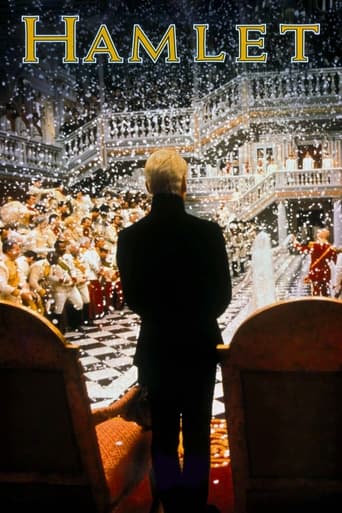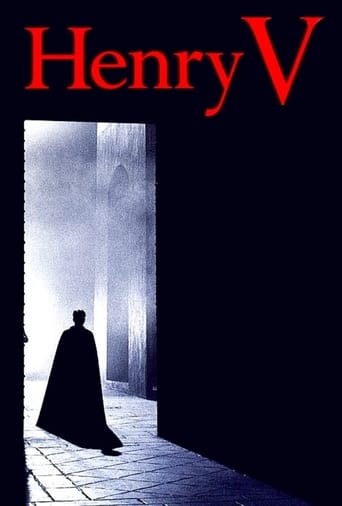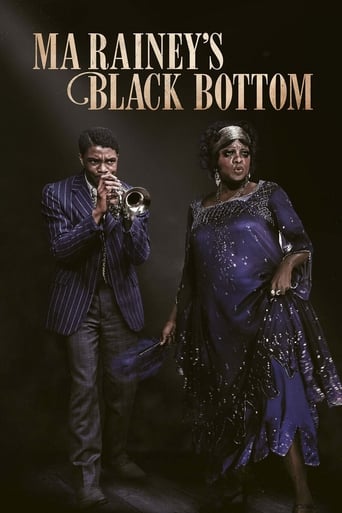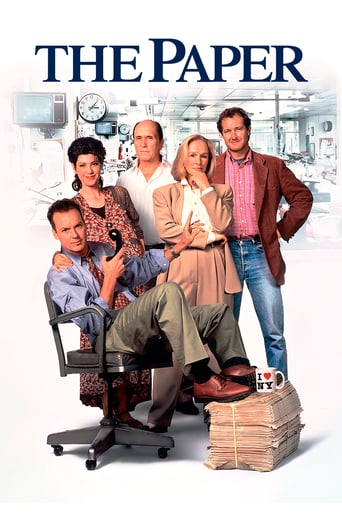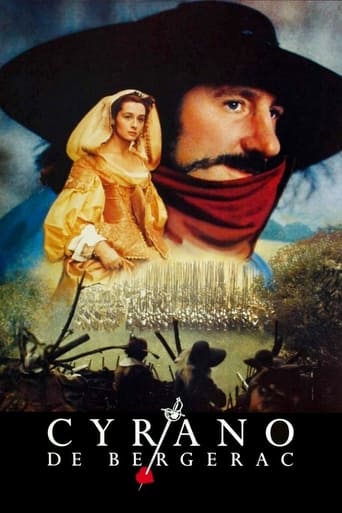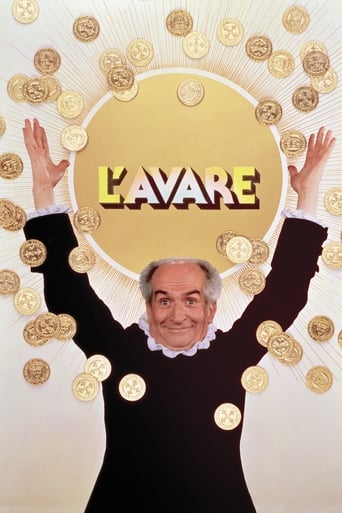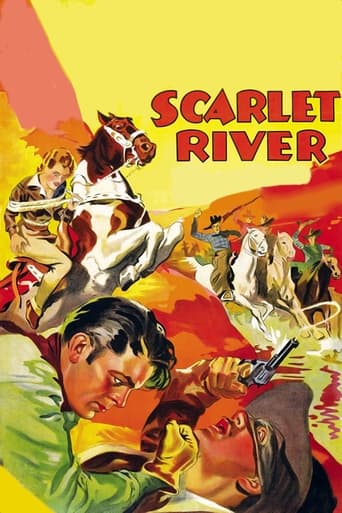Five Star Final (1931)
Searching for headlines at any cost, an unscrupulous newspaper owner forces his editor to print a serial based on a past murder, tormenting a woman involved.
Watch Trailer
Cast


Similar titles
Reviews
Five Star Final is 85 years old yet nothing has changed in that the public still has an appetite to read about filth in newspapers. The themes here would be looked at in many newspaper comedies throughout the 1930's, however this is no screwball comedy - it's deadly serious. I guess we can't say "back in my day journalists had ethics". The real life inspiration for Five Star Final came from a New York tabloid called New York Evening Graphic. At the time of the film release the Evening Graphic was losing circulation because its new editor was attempting to make it a more respectable paper, just like the character of Randall played by Edward G. Robinson the editor of the fictional tabloid newspaper The Gazette.Randall is an editor who is not without ethics. Despite the objections of the paper's management, "Randall won't print pictures of girls in underwear in the pictures section" and prints cables from The League of Nations. The pressure is on him to stop printing "actual news" and more sensationalist stories and gossip. When Randall gives in we see the full sleaze of Edward G. Robinson; after all nobody could do sleaze better than him.The stealer of the show however is Boris Karloff as Isopod. This isn't a horror movie but his performance feel like one straight from a horror picture with is distinctive, eerie voice. Isopod is a disgraced priest of whom Randall disguises as a practicing priest to go undercover and do the paper's dirty work; a creep who is full of crap and as Randall puts it "You're the most blasphemous looking thing I've ever seen". The name Isopod in Greek means 'even footed' but more commonly is the name an unpleasant looking order of crustacean parasites so I guess it works.The Gazette has a number of shady practices; they bully retailers and vandalise their stalls for not putting their papers on top. Likewise they employee a pretty girl played by Ona Munson to do dirty work for the paper although the main reason they're choosing her for the job is that she's not flat chested, as evident by the shot in which Aline MacMahon is clearly looking at her rack (even Isopod enjoys checking her out).In order the increase the circulation of The Gazette, Randall unearths a 20 year old murder case for the sake of a sensational story later titled, "Famous Killer's Girl to Wed Society Man". Today with this internet thing we've got going on it would be highly unlikely someone could hide the fact they were once tried for murder while Isopod could just get a photograph of the murder's daughter on Facebook. But the fact remains the same: sensationalist news stories can affect the lives of innocent associates.The film has a truly superb cast with everyone having their moment in the sun and this being a film set in the world of journalism, the dialogue flows at a rapid fire rate; a form of acting which is truly a thing of the past. Marian Marsh's breakdown at the end is hair raising melodramatic brilliance, even if her husband just happens to walk in as she pulls out a gun in a delightfully improbable turn of events.The production values are excellent helmed under the great director Mervyn Le Roy (such an impressive back catalogue). The use of sound in the opening credits with boys shouting "extra!" and the noise of the printing press sets the atmosphere while it's evident the studio strived for this production to have authentic sets. Many shots in Five Star Final have an impressive level of depth such as that of George E. Stone with his feet up in foreground as he sits back while on the phone.Five Star Final contains innovative use of split screen as Mrs Voorhes (Frances Starr) in the middle of the frame is trapped between paper employees who go about their business as usual and try to ignore her but also shows the paper as voyeuristic spies. Yes, the filmmakers sure love their symbolism here. Throughout the film Randall is constantly washing his hands ("50 times a day" apparently) while the paper employees going to the bar and drink in order to deal with their conscience. Likewise Randall's closeted love interest Miss Taylor played by Aline MacMahon has feelings towards him but objects to his job and the paper; she is symbolic of his conscious. To top it all off, the film ends with an image of the paper lying in the gutter like the filthy rag it is; a final powerful image to stick in your mind.
Another reviewer mentioned that this was ahead of its time and they were right. Most of these fuzzy black-and-white 1930s movies about detective, reporters, and one or another particeps criminis seem hastily flung together. They're pretty crummy. You await the outcome only because you're barely curious. It's like waiting for a particularly dull jigsaw puzzle to be completed, just because you've already invested so much time in it.Except for an unnecessary and hysterical ending, this one is exceptional. Robinson is the editor of a New York tabloid. The owners are all over him for the paper's low circulation, so Robinson orders his reporters to dig up the story of a twenty-year-old murder, a love tragedy, and find the woman who shot her philandering paramour. Dig into it. Find out where she lives, what happened to her, and we'll run a daily special on her crime and her current life.It's not such a hot idea from a moral point of view, a little like "Absence of Malice." The murderer, Nancy Voorhees, now Nancy Townsend (Frances Starr), has established a new life with a good man (H. B. Warner). Nancy's daughter, Marian Marsh, is a student at Hunter College and is supposed to marry a devoted young man from a family of social standing. The story wrecks their happy lives and leads to two suicides. Robinson, at the urging of his secretary, Aline MacMahon, tells off his bosses, throws a telephone through a glass door, and quits.A few observations. Almost everyone overacts, but that's to be expected in a year when sound was hardly established and silent-movie conventions prevailed. Frances Starr is especially egregious in this regard. There are moments when her performance looks like a parody.Robinson is introduced washing his hands, and MacMahon remarks that he does it compulsively, several times a day. (Cf., Lady MacBeth.) Prohibition was still the law in 1931, yet everybody saunters in and out of Corcoran's to have a drink. Robinson keeps a pint stashed in his desk drawer.There are some nice pre-code tickles in the dialog. Ziggie Feinstein is arranging a taxi race from the Bronx to mid-town and he's already fixed it. "I'm going to let an Irishman, a Jew, and a Wop win." When a low-life employee threatens to quit, Robinson gets to quote the Bible: "O, Death, where is thy sting?" Of his secretary, who sits and glares at him disapprovingly, "Don't just sit there like a visible conscience." And: "God gives us heartaches; the devil gives us whiskey." I don't claim these are flights of poetry, just that you're unlikely to find lines even of this level of originality as Philo Vance goes about solving a mystery.One of the lower forms of reporter is the silkily sinister Boris Karloff, who poses as a priest in order to get the dish -- when he's sober. The character's name is "Mr. Isopod." It's hard to believe that was an accident. In Greek it means "even footed" or even, by extension, "even handed," whereas in fact he's a scurrilous skank.
This is an amazing newspaper drama about a scandal sheet, the New York Evening Globe, that focuses on gossip, whether slander or not, destroying lives they have no business interfering in. And why bring up a 20 year old murder where the exonerated killer has reformed, lived a decent life, and is preparing to see the illegitimate daughter from that scandal be married into high society? Because that's what scandal sheets do, then, now, but hopefully not always. 82 years after this film was released, its message is still clear yet the attack it makes on these trash moguls has not been heeded, only worsened through today's hideous social media.The story here surrounds a woman (Frances Starr) who killed her lover who left her pregnant and refused to marry her. She was exonerated, married a man whom she truly grew to love (H.B. Warner) and has raised a beautiful daughter (Marian Marsh). At the Evening Globe, the owners suggest bringing back the story in serial form and find out what happened to her. Marsh's fiancée's (Anthony Bushell) parents are not forgiving, and as more of her past is exposed, Starr makes a drastic decision which results in tragedy for everybody and hopefully a guilt that will follow the Globe's owners to the grave.Under their thumb is Edward G. Robinson who goes along with the story yet as the clock ticks away, his own guilt surfaces, especially when Starr keeps trying to get ahold of him or the owners to beg them to cease the story for her daughter's sake. This is where the film is almost like the countdown to an execution, and the great tension arrives. Aline MacMahon, in her film debut, is outstanding, giving one of the greatest performances I've ever seen on film. She admits she's working in this position because it was the only job she can find, finds everything her employers do disgusting, and turns to drink to get the bad taste out of her mouth, hoping it will give her the courage to tell her boss (whom she obviously is in love with) off. Robinson finally gathers the courage to face the truth and his confrontation with his boss may have you cheering.In smaller roles as some of the sleazy reporters are George E. Stone, Ona Munson and Boris Karloff. The future King of Horror plays one of the sleaziest characters ever on film; He's a defrocked minister who continues to wear the uniform to get his victims to confide in him. Even Munson, playing pretty sleazy here herself, admits she is disgusted by him. The scene where Marsh confronts the Globe is celluloid at its eeriest with Karloff frightened out of his boots as he faces his sins at the hands of one of the victims.The reason these stories fascinate the public is obvious. As the musical "Sweet Smell of Success" (based upon the 1957 film noir) indicated, the public thrives on dirt, and they don't even care if it's true. You may, as I did, find this film to be an excellent expose on the evils of abuse because of the freedom of the press, yet you will be angry, as you should be. Think of that the next time you pass a newspaper rack at your local grocery store and see some innocent person's life being exposed in print or turn on your morning news to find out that it is not news, only unnecessary gossip.
Of all people, can that actually be Frankenstein groveling before a newspaper editor (Robinson). Yes indeed, it's the great Karloff as a reporter making extra nice-nice and a bit tipsy too—it does take some getting used to. He's certainly out of usual character, over-acting as well (perhaps the only time in a generally restrained career), but then exaggeration is the style of these early talkies.Karloff aside, the movie's a hard-hitting expose of the cut-throat newspaper industry back when 'extra editions' were the chief news outlet and people flocked around news stands. Pity poor Nancy Townsend (Starr). She's served her time for a sensational murder and is now a respectable housewife. Trouble is the Gazette, its greedy owner, and editor Randall, need to boost circulation, so why not resurrect her murder case. Who cares that it may ruin her now reformed life when there's extra dollars to be made. Some pretty dramatic scenes ensue, and few punches are pulled, especially that sardonic very last shot.No doubt about it, director LeRoy is one of the masters of early talkies. The staging of the two tragic Townsend scenes is movingly done, while the split screen run-around really brings out the cruelty of the Gazette staff. This is pre-Code (1931) and some innuendo surfaces at the beginning with chippie Kitty Carmody (Munson), otherwise there's little that post-1934 would find objectionable.This is First National Pictures on the eve of merging with Warner Bros. to complete that powerhouse studio of the 1930's. There's Warner's trademark vigor and 'every dayness' that help lift this movie beyond the ordinary and also show why the very unglamorous Robinson was such a force in early talkies. All in all, it's a smoothly energetic installment in pre-Code Hollywood.In passing-- catch that 1930 state-of-the-art radio, almost big enough to sleep in. These really old movies are a good chance to view early editions of familiar technology and be entertained at the same time.

